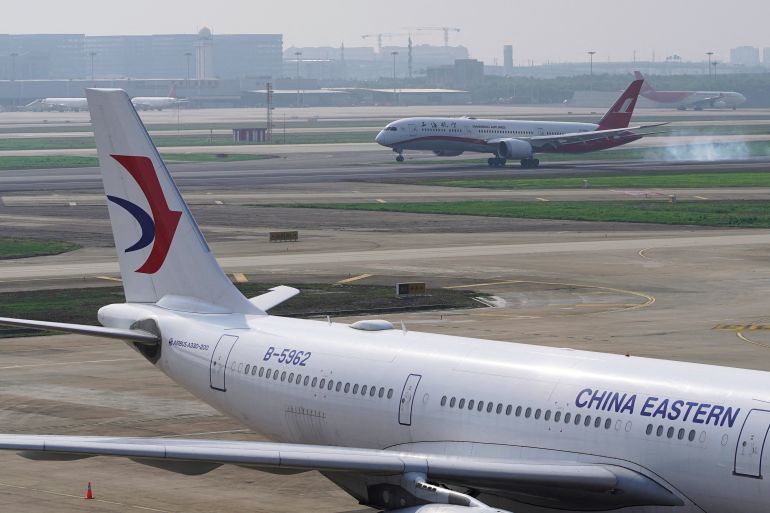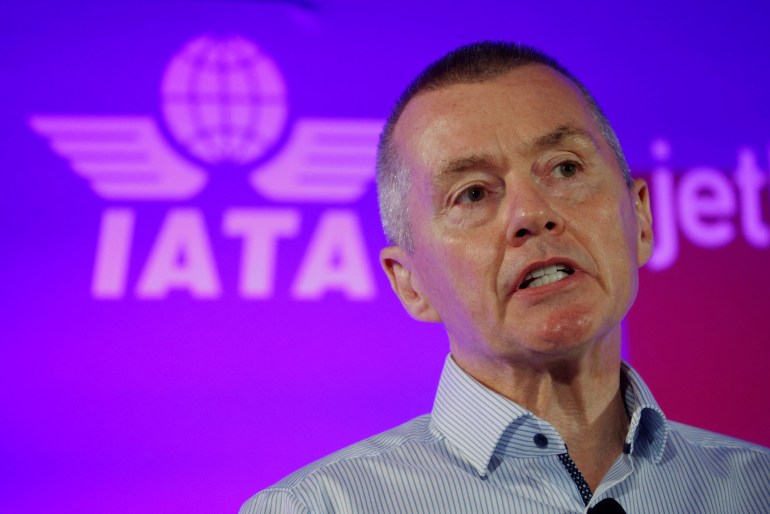‘Jobs are at stake’: Asia ‘playing catch-up’ on post-COVID travel
The head of the global airline body says the region falling behind the rest of the world on restarting international travel.

Asia-Pacific countries are “playing catch-up” on restarting international travel and should ease remaining pandemic-related border restrictions without delay, the head of the global airline industry’s representative body said on Tuesday.
Speaking at an aviation summit in Singapore, Willie Walsh, director general of the International Air Transport Association (IATA), said the region had fallen behind the global trend despite “growing momentum” towards lifting restrictions.
Keep reading
list of 4 itemsHikvision sanctions signal uncharted waters from UK to Vietnam
Turkey confirms opposition to NATO membership for Sweden, Finland
N Korea reports fever surge as military ramps up COVID response
“The demand for people to travel is clear. As soon as measures are relaxed there is an immediate positive reaction from travellers,” Walsh said in a keynote address to the Changi Aviation Summit. “So it is critical that all stakeholders, including governments, are well-prepared for the restart. We cannot delay. Jobs are at stake and people want to travel.”
Walsh said air travel in the region during the first quarter of 2022 was just 17 percent of 2019 levels – compared with about 60 percent in Europe, North America, and Latin America.
“Things are improving, but they will not improve fast enough unless countries follow the initiative of countries like Singapore and remove the requirements for tests and quarantine for vaccinated travellers,” said Walsh, who previously served as the CEO of British Airways and Ireland’s Aer Lingus.

Walsh said governments should scrap all restrictions for vaccinated travellers and quarantine and COVID-19 testing for unvaccinated arrivals in the majority of destinations that have high levels of population immunity.
“Things are improving, but they will not improve fast enough unless countries follow the initiative of countries like Singapore and remove the requirements for tests and quarantine for vaccinated travellers,” he said. “The science supports these initiatives.”
While most countries in the region have welcomed the return of tourists in recent months, many destinations still require a COVID test that leaves travellers at risk of missing their flight or being sent to quarantine.
Walsh singled out China and Japan, the last holdouts to large-scale travel along with Taiwan, as major holes in the region’s recovery.
Tokyo on Tuesday announced it would begin allowing limited package tours from this month as a “test” to gather information for a broader resumption of tourism at an unspecified later date. Beijing, which has doubled down on an ultra-strict “dynamic zero COVID” policy to eliminate the virus, has given no indication of when China might reopen its borders.
“So long as the Chinese government continues to maintain their zero-COVID approach, it is hard to see the country’s borders reopening. This will hold back the region’s full recovery,” Walsh said.
“While Japan has taken steps to allow travel, there is no clear plan for the reopening of Japan for all inbound visitors or tourists. More needs to be done to further ease travel restrictions, starting with lifting quarantine for all vaccinated travellers, and removing both the on-arrival airport testing and daily arrival cap. I urge the government of Japan to take bolder steps towards recovery and opening of the country’s borders.”
‘Can’t be replaced’
Gary Bowerman, director of Kuala Lumpur-based travel and tourism research firm Check-in Asia, said the region’s slow recovery underscores the outsize importance of China and Japan to travel and tourism.
“China for instance provided 32 million visitors, almost one-quarter of all visitors, to ASEAN in 2019. That level of visitation simply can’t be replaced,” Bowerman told Al Jazeera.
“Southeast Asia and Australia rely heavily on air traffic from China and Northeast Asia. Until China reopens, the recovery in Southeast Asia, for example, has a much lower ceiling. The region’s air travel ecosystem badly needs China because it combines a mix of Chinese carriers, national carriers and low-cost carriers.”